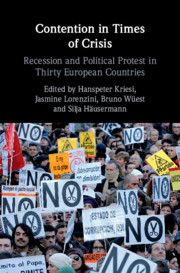Book contents
- Contention in Times of Crisis
- Contention in Times of Crisis
- Copyright page
- Contents
- Figures
- Tables
- Contributors
- Preface and Acknowledgements
- Part I A Study of Protest in Thirty European Countries
- Part II Trends in Protest in the Great Recession
- 4 Overall Trends of Protest in the Great Recession
- 5 All Quiet on the Protest Scene?
- 6 The Return of the Economy?
- Part III Sources of Protest
- Part IV Interaction Between Convention and Contention
- References
- Index
5 - All Quiet on the Protest Scene?
Repertoires of Contention and Protest Actors During the Great Recession
from Part II - Trends in Protest in the Great Recession
Published online by Cambridge University Press: 13 August 2020
- Contention in Times of Crisis
- Contention in Times of Crisis
- Copyright page
- Contents
- Figures
- Tables
- Contributors
- Preface and Acknowledgements
- Part I A Study of Protest in Thirty European Countries
- Part II Trends in Protest in the Great Recession
- 4 Overall Trends of Protest in the Great Recession
- 5 All Quiet on the Protest Scene?
- 6 The Return of the Economy?
- Part III Sources of Protest
- Part IV Interaction Between Convention and Contention
- References
- Index
Summary
The choice of specific action repertoires allows protesters to increase their visibility and eventually their success. A rise in protest, i.e. a protest wave, often comes with a qualitative expansion of the conflict, which can take two forms: changes in the action repertoire and a growing diversity of involved actors. In this chapter, we examine the types of protest and the types of actors over time. In so doing, we ask whether and how the Great Recession transformed customary action repertoires in southern, north-western, and eastern Europe. Hence, we show variations in the use of commonplace action forms, i.e. demonstrations, strikes, and confrontational and violent actions. We find that demonstrations and strikes remain the dominant form of protest across regions and time periods, while transformations in the action repertoire of contention, in the form of violent events, took place only in some parts of the south and were short lived. Lastly, we turn to actors and we show that protest events increasingly feature social groups without formal organizational structures. We conclude by arguing that contention repertoires remained largely unaffected by the Great Recession; demonstrations were and remained the prevailing form of protest in all three regions during the whole period under study.
- Type
- Chapter
- Information
- Contention in Times of CrisisRecession and Political Protest in Thirty European Countries, pp. 104 - 127Publisher: Cambridge University PressPrint publication year: 2020
- 1
- Cited by



